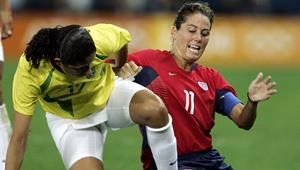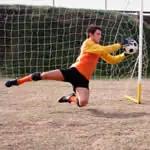As a young player, I once asked how far a soccer player ran during a game.
This guy from "the old country" said 10 miles. So I divided 10 miles by 90 minutes. To cover 10 miles would require a constant running pace of almost seven miles per hour and I knew intuitively that 10 miles couldn't be correct.
Knowing how, and how far, a player runs is important in designing training programs and determining how far a player runs is very difficult.
First you have to videotape a game with a camera that doesn't follow the ball. Then play it back while you focus on one player, recording every movement they make while estimating the pace and distance they run. Then rewind and do it all over again for the next player. Labor and time intensive is an understatement for these projects.
The first time-motion study over a full season was done on Everton FC (Liverpool, England) in the mid 1970s and the estimated distance covered was just under 8,800 meters per game.
Movement speeds were walking, jogging, cruising ('running with manifest purpose and effort'), sprinting and backing.
About 2/3 of the distance was covered at the low intensities of walking and jogging and around 800 meters sprinting in numerous short 10-40 meter bursts.
A player was in control of the ball for an average of 200 meters for a whopping total of 90 seconds (that means you spend 88.5 minutes trying to get or keep someone from getting the ball).
More on Soccer Conditioning
- Visit Active's Soccer Conditioning Guide
to learn more about the
fitness side of the world's game.
Recording every change of speed and direction showed that there was some change in activity every 5-6 seconds. Subsequent work and maturation of the game has pushed this total distance up to around 10,000 meters for a men's professional European game with the South American game being contested at a little less total running distance.
Midfielders run the most, central strikers and defenders the least. Don't brag too much about the running volume--10,000 meters (six miles) in 90 minutes is four miles per hour, something a good power walker can do.
The physiological intensity of the game can be estimated one of those heart monitors you see joggers and cyclists wearing. The average heart rate for the full 90 minutes ranges between 150-170 beats per minute with very high values while sprinting and more moderate values when less involved in the game.
I remember charting one women's national team member who averaged 185-190 beats per minute for the whole game.
One interesting observation that doesn't take an "A" license to figure out: the most physically intense part of the game is while in control of the ball.
Your pulse rate goes up and lactic acid production (that heavy feeling in your legs you perceive after sprinting) increases. This is a primary reason why coaches sets up lots of small sided games that force players to be 'on the ball' far more often than during 11 v 11.
Generally, the women's game is a little less running and at a slower pace (about 75 percent of the women's game is at a walk/jog), but when conditions demand it, the women can cover just as much distance as the men.
And, realize that women have a smaller capacity, so when they cover the same distance as men playing the same game on the same field for the same time as men, they are working harder.
Now that we know some details about the game, the focus of training begins to become clearer. The other pieces in the training puzzle are game tactics.








Discuss This Article